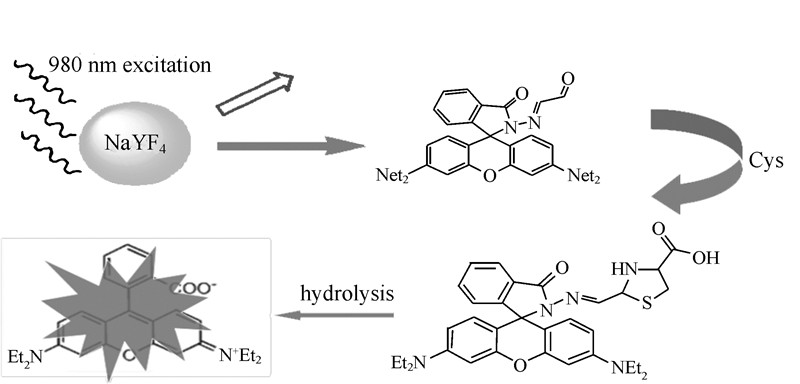Sensing application and mechanism of organic-inorganic nanocomposites
-
摘要: 有机-无机杂化复合纳米材料可以在微观尺寸上将有机和无机组分相结合,使复合材料兼具两种组分的优点,实现所需的性能或功能,因此成为材料学的研究热点之一。本文以有机荧光染料罗丹明、三苯胺和金属配合物发光材料为母体,制备出一系列对汞离子、铜离子、铁离子等常见金属离子具有明显光谱响应的探针类材料并选取合适的支撑基质组装成有机-无机复合材料,实现了对金属离子和一些阴离子的目视比色传感。不同离子的加入及加入顺序都会对探针类材料的吸收及发光光谱造成明显的变化。以不同的金属离子或氧气作为输入值,以吸收强度/发光强度作为输出值,模拟了分子水平的逻辑门,拓展了这些材料的应用。为了解决背景荧光干扰,我们利用六角相的β-NaYF4纳米晶为激发源,采用二氧化硅进行包覆,然后将荧光探针分子固载到二氧化硅表面,得到了对金属离子具有传感性能的核壳型的上转换纳米复合材料。在近红外激发下能够显示明亮的上转换绿光发射,同时对金属离子具有较好的选择性、较高的灵敏度,并且其荧光强度表现出对汞离子浓度的线性响应。这种纳米复合材料的上转换光学性质、汞离子传感性能使它们在分析化学、生物化学等领域有潜在的应用价值。Abstract: As one of research hotspots, organic-inorganic nanocomposite materials combine virtues from both components at microcosmic level, achieving desired function and performance. This paper prepared a series of probe materials for Hg(Ⅱ), Cu(Ⅰ), Fe(Ⅲ) etc. using starting chemicals of rhodamine, triphenylamine and emissive metal complexes. These probes were embedded into proper matrixes to construct composite materials, realizing naked-eye colourimetric sensing towards metal and anion ions. Different ions and their sequence led to spectral variations of absorption and emission spectra. Molecular logic gates were simulated using metal ions or oxygen as input, absorption/emission as output, respectively, widening application of these probes. Hexagonal β-NaYF4 nanocystals were prepared and used as excitation source to eliminate background light interference. Probe molecules were covalently grafted onto these silica coated β-NaYF4 nanocystals, giving core-shell structured up-conversion sensing composites. Upon IR radiation, up-conversion green light was observed, showing good selectivity and sensitivity to metal ions with linear response. Above up-conversion and sensing features made corresponding nanocomposites a promising candidate in analytical chemistry and biochemistry.
-
Key words:
- composite materials /
- naked-eye colourimetric analysis /
- sensing /
- luminescence /
- magnetic
-
图 19 (a)铕配合物在各种阴离子条件下的光谱响应;(b)铕配合物的光谱响应情况(氯离子,溴离子和高氯酸根离子,浓度为50 μmol/L;磷酸二氢根离子,氟离子和醋酸根离子,浓度为20 μmol/L)。插图:364 nm照射下配合物对不同阴离子的响应,检测波长为610 nm
Figure 19. (a)PL spectra response of Eu(DBM)3DPPZ(5 μmol/L) to various metal ions;(b)PL spectra response of Eu(DBM)3DPPZ to 50 μmol/L of Cl-, ClO-4, Br-; 20 μmol/L of H2PO-4, AcO-, F-. Inset:corresponding photos under UV radiation(λExcitation=365 nm, λemission=610 nm)
-
[1] [2] [3] [4] [5] [6] [7] [8] [9] [10] [11] [12] [13] [14] [15] -






 下载:
下载:








































